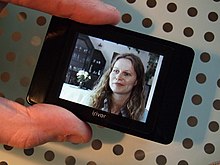
Back Radiodifusió multimèdia digital Catalan Digital Multimedia Broadcasting Czech Digital Multimedia Broadcasting German Digital Multimedia Broadcasting Spanish Terrestrial Digital Multimedia Broadcasting French Digital Multimedia Broadcasting ID Digital Multimedia Broadcasting Italian DMB Japanese 디지털 멀티미디어 방송 Korean Penyiaran Multimedia Digital Malay
This article needs additional citations for verification. (April 2021) |


| Digital multimedia broadcasting | |
| Hangul | 디지털 멀티미디어 방송 |
|---|---|
| Hanja | 디지털 멀티미디어 放送 |
| Revised Romanization | Dijiteol Meoltimidieo Bangsong |
| McCune–Reischauer | Tijit'ŏl Mŏltimidiŏ Pangsong |
| List of digital television broadcast standards |
|---|
| DVB standards (countries) |
| ATSC standards (countries) |
|
| ISDB standards (countries) |
| DTMB standards (countries) |
| DMB standard (countries) |
| Codecs |
|
| Terrestrial Frequency bands |
| Satellite Frequency bands |
Digital multimedia broadcasting (DMB) is a digital radio transmission technology developed in South Korea[1][2][3] as part of the national IT project for sending multimedia such as TV, radio and datacasting to mobile devices such as mobile phones, laptops and GPS navigation systems. This technology, sometimes known as mobile TV, should not be confused with Digital Audio Broadcasting (DAB) which was developed as a research project for the European Union.
DMB was developed in South Korea as the next generation digital technology to replace FM radio,[4] but the technological foundations were laid by Prof. Dr. Gert Siegle and Dr. Hamed Amor at Bosch in Germany.[5] The world's first official mobile TV service started in South Korea in May 2005, although trials were available much earlier. It can operate via satellite (S-DMB) or terrestrial (T-DMB) transmission. DMB has also some similarities with its former competing mobile TV standard, DVB-H.[6]
- ^ "Korea's Terrestrial DMB: Germany to begin broadcast this May". ZDNet Korea. Retrieved 2010-06-17.
- ^ "picturephoning.com: DMB". Textually.org. Archived from the original on 2010-08-09. Retrieved 2010-06-17.
- ^ "South Korea : Social Media 답변 내용 : 악어새 - 리포트월드". Reportworld.co.kr. Archived from the original on 2009-08-17. Retrieved 2010-06-17.
- ^ "The Introduction of DMB in Korea" (PDF). Ericemoon.googlepages.com. Archived from the original (PDF) on 2009-03-26. Retrieved 2010-06-17.
- ^ "Sichere Bewegtbildübertragung zum mobilen Teilnehmer". deutscher-zukunftspreis.de. 1998. Archived from the original on 2013-06-28. Retrieved 2019-11-27.
- ^ "T-DMB". Eng.t-dmb.org. Archived from the original on 2010-02-13. Retrieved 2010-06-17.